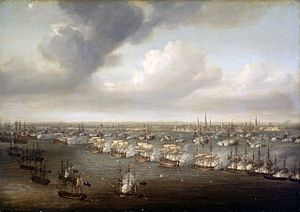William Birchall facts for kids
Quick facts for kids
William Birchall
|
|
|---|---|
| Born | 1769 Bath, Somerset, UK |
| Died | 1817 (aged 47–48) Exeter, Devon, UK |
| Buried |
St Sidwell's Church, Exeter
|
| Allegiance | |
| Service/ |
|
| Rank | Post-captain |
William Birchall (1769–1817) was a brave officer in the Royal Navy, Great Britain's powerful sea force. He served during important conflicts like the French Revolutionary Wars and the Napoleonic Wars. He became a lieutenant in 1790. He was on the ship HMS Montagu during the famous Glorious First of June battle.
Birchall became a commander because he showed great courage and skill. This happened during a special "boat action" against a French privateer (a private ship allowed to attack enemy ships). He was later promoted to post-captain after the Battle of Copenhagen in 1801. In 1803, he led the Chester region's Sea Fencibles, a group of local defenders. William Birchall passed away in Exeter in 1817.
Contents
William Birchall was born in Bath, Somerset, in 1769. His father was a cabinetmaker. We don't know much about his early years. But we do know he became a lieutenant on 18 June 1793. News reports said he had already spent 13 years as a midshipman, learning to be an officer.
When he was promoted, Birchall was serving on HMS Montagu. He stayed with this ship as it sailed to the West Indies. He was likely still on board when it fought in the Glorious First of June battle in 1794.
Fighting French Privateers
By 1796, Birchall had joined HMS Santa Margarita. He was the second-in-command to Captain Thomas Byam Martin. In October, Santa Margarita had two fights with French privateers in the English Channel. They had already captured a 16-gun ship called Buonoparte.
On the night of October 23, two more ships approached Santa Margarita. They came close, then suddenly moved away. Santa Margarita fired at them and chased the larger ship. Meanwhile, Birchall and five others got into a small boat. They went after the other ship, which was damaged. They boarded and captured it. It turned out to be the Potomac, a former British merchant ship now controlled by a French crew. Santa Margarita then caught the larger ship, the 16-gun Vengeur, and forced it to surrender.
Leading Ships and Missions
Birchall was praised for his "Zeal and intrepidity" (great energy and bravery) during the fight for the Potomac. Because of this, he was made a commander in 1797. By 1798, he was in charge of the Hebe. This ship was lightly armed but very fast.
Stopping an Invasion Plan
In May 1798, Hebe was part of a group of ships led by Home Popham. Their mission was to stop French barges from moving from Vlissingen to Dunkirk. These large, flat-bottomed boats were meant to carry troops across the Channel. Napoleon's planned invasion of the United Kingdom was a big threat.
The French boats were traveling through Belgium's waterways to Ostend. The British planned to stop them by destroying the lock gates there. A force of 25 small ships and over 1,000 soldiers gathered at Margate. Many soldiers were on board Hebe.
The expedition sailed on May 14 and arrived on May 19. Soldiers landed in bad weather while Popham's ships fired to protect them. Some smaller British ships were damaged by enemy cannons. But Hebe, being stronger, was able to move closer to shore and keep firing. The soldiers completed their mission. However, bad weather stopped them from getting back on their ships. A larger French force captured them the next day.

Battle of Copenhagen
In March 1800, Birchall took command of the 18-gun ship HMS Harpy. In January 1801, Harpy and another ship recaptured the Constitution. This ship had been taken by French privateers.
Before the Battle of Copenhagen in April 1801, Harpy was one of the smaller ships that helped. They measured the water depth and marked safe paths for Horatio Nelson's fleet. This allowed most of Nelson's ships to pass safely and fight the Danish fleet. After the battle, Birchall saw the Danes trying to move one of their ships away. He quickly attached a rope to the Danish ship Sjaelland and towed it away as a prize.
Birchall and Harpy stayed near Copenhagen to make sure the peace agreement was followed. They also told other British ships that Nelson's fleet had sailed to Bornholm. For his brave actions, William Birchall was promoted to post-captain.
Later Life and Passing
In 1803, Birchall was put in charge of the Chester region's Sea Fencibles. These were local volunteers who defended the coast. A newspaper reported a disagreement in December. Birchall had tried to make a local militia member join the navy. The militia reacted strongly, attacking the jail and tearing down Birchall's flag. Birchall was asked to leave town while the army brought order back.
Birchall married three times but did not have any children.
He passed away in Exeter in 1817. He was buried at St Sidwell's church in Exeter. This church was later destroyed during World War II in the Exeter Blitz of 1942.

